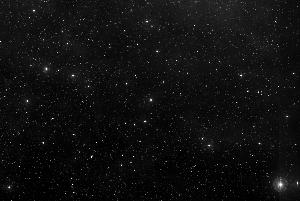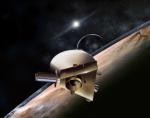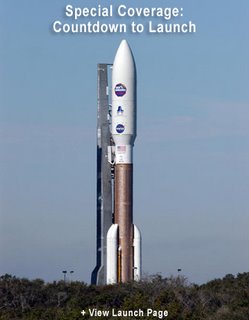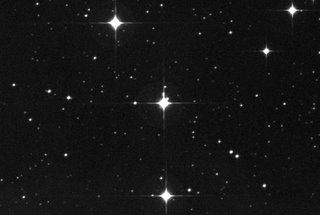
This is a yellow giant Mag 4.14 star which is 174 Light Years Away. To the upper right is the bright star Tau Orionis Mag 3.60. To the bottom right one can just about see the brilliant glow of Rigel. To the top left one can just about see HR1840 and Thabit.
Using my 20x80 binoculars in the field of 29 Orionis and going from center south and then anticlockwise towards south west are
HD35261 Mag 7.58
HD35353 Mag 7.69
HR1778 Mag 5.90
HD35155 Mag 6.86
Travelling north west from there
HD34892 Mag 7.54
Although stable hydrogen gas is invisible optically, its presence is especially concentrated along the disk of our galaxy in its vast spiral arms. One such region is associated with the Orion Complex. So take some time to scan the sky due south of 3.4 magnitude Eta Orionis and note how few stars are visible between it and 4.2 magnitude 29 Orionis - some 5 and a half degrees away. Such regions are known to have high concentrations of 21 cm radiation caused by hydrogen gas that has yet to begin coalescing into new Suns such as our own.
Further details can be found at
http://www.universetoday.com/whatsup/Whats-Up-2006-365days-Q1-Jan-Feb-Mar.pdf
Observation Details for 29 Orionis
HR 1784 HD 35369 SAO 132067, BD -7 1064
Flamsteed Number: 29
Bayer Letter:
Constellation: Orion
Visual Magnitude: 4.14
Color Index: 0.96
Spectral Class: G8IIIFe-0.5
Annual Proper Motion: -0.015 -0.043
J2000 RA: 5h23m56.80s DE:-07°48'29.0"
Date RA: 5h24m14.34s DE:-07°48'10.1"
Birmingham 2006-1-22 11h01m ( TU + 0h00m )
Sideral Time : 19h00m
Hour Angle : 13h36m
Azimuth :+32°22'
Altitude :-40°34'
Rise : 16h04m Azimuth:+102°08'
Culmination : 21h27m
Set : 2h50m Azimuth:+257°52'
Further details can be found at
http://www.heavens-above.com/hipentry.asp?hip=25247
http://www.geocities.com/CapeCanaveral/Launchpad/6425/sumstars/summap1.html
http://www.dibonsmith.com/ori_b.htm
http://www.dudeman.net/spacedog/const/s-sum.shtml
We have another 85 years to go before we discover the Zen Rigeln in the 29 Orionis star system.
http://www.ssdc.com/games/GalacticTimetable.html














